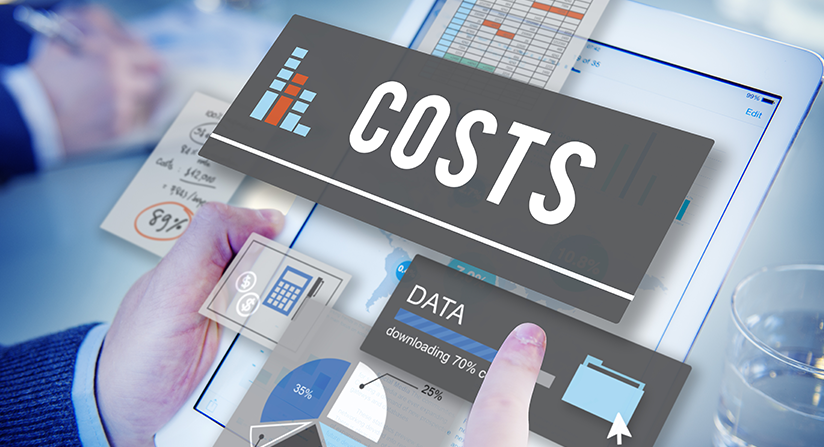Trying to select an ERP system is complicated and so is comparing pricing. That’s because there are so many variables that affect the cost. If you want to determine if your business can afford an ERP system, remember to take into account the ROI it will provide as well as how it can help your company compete and grow.
To give you a quick idea of ERP system cost, this 2021 ERP Software Report shows an average cost of $8,265 per user with an average of 26% of employees as users. As you go through the process of selecting an ERP system, you’ll need a systematic approach to determine ERP cost. This article provides a comprehensive breakdown of the variables to consider when trying to determine ERP software price as well as an explanation of each. In addition, here is an ERP Cost Template to use as you go through the process of calculating ERP system prices.
A Step-by-Step Guide to Determine ERP Software Price
ERP Software Licensing Costs
1. On-premise ERP System Price
- One-time Perpetual License Fee
ERP software is available on-premise and cloud-based. With on-premise, there is a one-time perpetual license fee which is either based on the size of the organization or the number of concurrent users. The license cost per user is more expensive than the cloud (about 2.5 to 3.5 times more) since it is billed up-front vs. the cloud which has monthly user fees.
2. Cloud-based or SaaS ERP System Price
- Named User Fee Option
The named user is the most common user license model and is priced by the number of named users. A Named User License is a fixed license that is assigned to a user who will always maintain that slot to access the software. The named user option includes different costs for standard users, manager users, and admin users with the admin users at the highest price since they are granted the greatest access. - Concurrent User Fee Option
A Concurrent User License is a finite amount of licenses purchased to be shared, but only one person per license can be logged in at any time. For example, if 10 licenses are purchased, only 10 people can be using the software at the same time. This can be a good option for companies that have users working in shifts. - Consumption-based User Fee Option
A Consumption-based User License is formulated on the volume of transactions such as sales orders and invoices and allows for an unlimited number of users. As a company grows, this could get expensive as transactions increase. This option would be a good model for a company that has a low volume of transactions, for instance, a business that produces high-end custom equipment where they don’t sell a large quantity, but each product is expensive.
3. Add-on Software Licensing Costs
If the ERP system you choose has gaps in some areas, you may need to add some other software applications. Maybe you need stronger capabilities in a specific area such as manufacturing, so you need software that can accommodate those needs. Since the add-on(s) is not part of your ERP project, there will be an additional licensing cost that you’ll need to add to your total licensing costs.
4. Integration Licensing Costs
- Integration Software
If you have add-on software that needs to work with your ERP system, you may require an integration platform, which is also software, that allows the two (or more) systems to work together. - Integration Code
Or optionally, you may need someone to create custom integration code if there isn’t already a pre-integrated option for the add-on(s). It’s also possible that you will need to pay for licensing privileges to allow the systems to communicate together.
5. Additional ERP Price Costs
- Optional Modules/Features
Some vendors may charge additional fees if a module(s) is not part of the base price or there may be advanced features needed that are also not part of the original software. Be clear on the functionality you will need when discussing price to ensure there are no surprises down the line.
ERP System Implementation Costs
The cost of implementations can vary depending on many things, but it is the most expensive part of your ERP purchase, however, it is a one-time cost. You can anticipate that it will cost you between 1.5 to 2.5 times the cost of the software itself.
1. Implementation Consultant
Hiring a good ERP consultant can prove to be very useful, especially if you do not have an internal resource who is experienced with implementing an ERP system. It will be important to have someone who knows your industry well to be effective. They should both know the ERP system you plan to use as well as have experience working with other companies that are similar to yours.
Consultant Implementation Pricing Models
- Fixed Price Contract – With the fixed price model, there is a pre-defined price based on the expected scope of the project. It’s important that the scope of work is clearly defined in detail and that both parties have clear expectations.
- Time and Material – This model charges based on how much time is spent and for any material that is used. This method would be useful if the scope is not clear, if flexibility is needed, or if speed is required to get started on the project since this type of contract is simple to create.
- Recurring Model – With this model, you pay per day or month which could be distributed over a period of years. It provides the consultant with predictable and fixed revenue and it allows the client some flexibility. It is also easier to keep track of than the time and material model.
As with any contract, read it carefully and ask questions about anything concerning. Carefully consider how much time you will need from the consultant. It may be a lot if you are new to ERP so even though a fixed price contract might seem appealing, it might not make sense if it doesn’t end up covering all of the work you’ll need from them. You could end up paying a high hourly rate to complete the job after the contract expires. Think all of the options through and be sure to have a clear definition around your agreement.
2. Customization
Based on how your business operates and how flexible you are on adapting your processes to the system, you may need customizations to the software to have it work with your unique processes and needs. Your provider will charge you for customizations so try to keep them to a minimum. When implementing a modern ERP system, it probably makes sense for you to adjust your processes to work with the software since it is most likely based on best practices for today’s businesses.
When you customize a system, it can potentially cause merge issues with software updates and upgrades since the program no longer works as it originally did. If you need a lot of customizations, the system may not be the best choice for your business and you may want to reconsider your selection.
3. IT Infrastructure
- Hardware/Software – This cost is only applicable for an on-premise ERP system, or if you have add-on software that is not cloud-based. Your vendor should provide you with a requirement sheet for software and hardware that is necessary for the implementation and use of their system.
- You will need to either work with your in-house IT staff if they are capable or hire a professional that can work to get all of your required hardware and software operational. If you are using a consultant, they may have the capability to get your IT infrastructure set up for the ERP implementation, or they may hire another company if that is not part of their expertise.
4. Internal Staff Costs
This is an important cost and one that is often overlooked.
- Project Staff – You will have project staff that will be deciding which system to select and they will continue to be involved throughout the implementation. They are likely to work a good amount of overtime so factor that into the cost of their time.
- Temporary Staff – You may need to hire additional staff, temporary staff, or consultants since the people that are working on this project have jobs that will need to be covered.
- IT Staff – If selecting an on-premise system, you’ll have IT staff working with the vendor on your internal infrastructure to support the ERP system. An IT staff is often not needed or at least minimized with a cloud-based system.
5. Data Migration
You will need to have data entry, testing, and data conversion to migrate data from your legacy system to your new system and to ensure your data is set up properly for your ERP system. Your vendor may help with some of this, but data migration will mostly be your responsibility, so use staff or temps for these tasks. Remember that data migration is often under-budgeted, so keep that in mind as you determine a figure for this expense.
6. Training
Your vendor may provide some free basic training, but often it is at an additional cost (e.g., travel costs) particularly if it is done at your site. Training is crucial to ensure your staff is comfortable with the system and using the software to its full potential.
Implementing an ERP system is not an inexpensive venture so you want to be sure you get the most out of your system. Don’t skimp on good training. You will be able to have some people train first on the system and then teach others, but those staff must have a solid understanding of the system before they begin instructing others.
Ongoing ERP System Costs
IT Staff
As mentioned earlier, IT staff will be needed for an on-premise solution to manage any technical difficulties that might occur. You’ll need someone that can troubleshoot issues to ensure users stay productive.
Support
Most vendors have a knowledge base on their website and provide basic support for some time. It may be wise to also consider a paid plan that covers more advanced support to ensure if you have a problem you can get the help needed.
Maintenance/Upgrades
With cloud ERP, annual maintenance and upgrades are often included in the subscription pricing. However, for on-premise, there is a fee that covers annual maintenance and software upgrades. It’s a good idea to keep your software up-to-date to ensure it is supported and to have the new technologies upgrades offer.
Considerations for Your ERP Budget
When putting together your ERP budget, here’s a bulleted list of the important things to take into consideration no matter what type of system you choose.
- What license options are available.
- How many people will need access to the ERP system.
- How many locations or entities will be using the ERP software.
- How much complexity there is to your business processes.
- What you will need for training to get your users comfortable with the ERP system.
- What industry functionality you may need.
- What customization might be necessary.
- What hardware/software you’ll need to purchase for implementation.
- How much time will be involved with your data conversion/migration.
- What your projected consumption volume will be.
- How much staff time will be needed for the project.
- If you’ll need any third-party applications and their level of complexity.
- How frequently the ERP vendor publishes updates and upgrades.
Conclusion
As you can see, there are a lot of variables and considerations when determining the cost of an ERP system. Unfortunately, it isn’t straightforward as every vendor can be different in how they handle pricing. A cloud ERP system is the simplest since you don’t have to add any servers or worry about your IT infrastructure or maintenance. Cloud ERP licensing fees are also considered operating expenses whereas on-premise ERP costs are considered capital expenditures.
To help you break down the complexity of ERP system price, you can download our template to help you in the process. If you are a manufacturing or distribution company and would like information on an industry-specific ERP system contact our team who will be happy to answer any questions.
Follow Us




